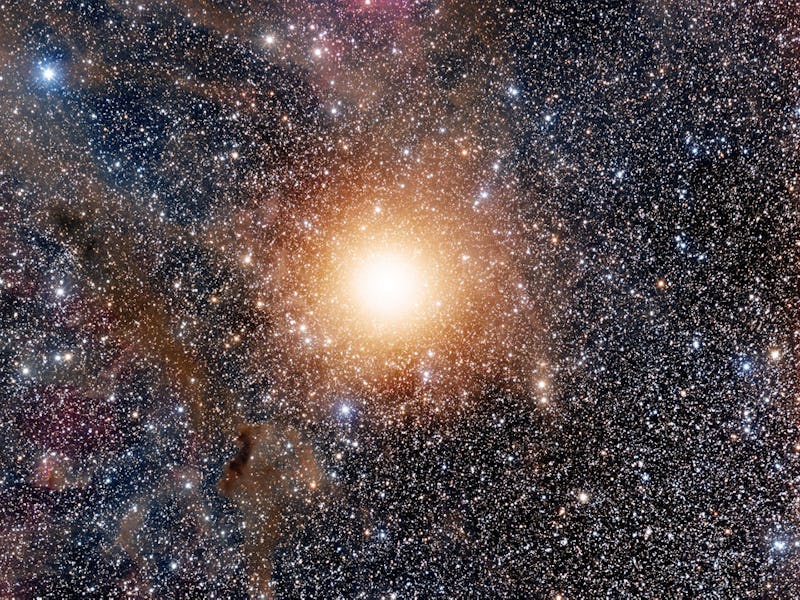NASA's Hubble telescope solves the curious case of Betelgeuse
The bright star's sudden dimming may have been a sudden outburst.

The saga of Betelgeuse has been ongoing for nearly a year now. When the bright star began to suddenly dim, reaching a shocking 40 percent of its regular luminosity, astronomers held their breath — secretly hoping that the star would explode in a massive supernova before our eyes.
Today, Betelgeuse shines at its usual brightness but a mystery endures: Scientists have not yet been able to determine what initially caused the sudden dip in brightness.
However, new observations by the Hubble Space Telescope may have finally cracked the curious case.
The findings were published Thursday in a study in the Astrophysical Journal.
Based on the data recorded by NASA's Hubble Space Telescope, researchers hypothesize that the dimming of the red, supergiant star was likely caused by the sudden ejection of a massive amount of hot material that blocked the star's light from reaching us here on Earth.
A four panel graphic that illustrates the outburst of material that blocked Betelgeuse's starlight from reaching Earth.
The problem of the pulsation cycle — The results relied on several months of observations by Hubble, beginning in January 2019. Hubble captured signs of dense, heated material moving through the star's atmosphere in September, October, and November 2019, according to NASA.
In December 2019, that's when astronomers began noticing that Betelgeuse was starting to lose its signature brightness. By January 2020, Betelgeuse had dimmed by 25 percent and in February, the star was at 40 percent of its usual brightness, as reported in The Astronomer’s Telegram.
“With Hubble, we see the material as it left the star’s visible surface and moved out through the atmosphere, before the dust formed that caused the star to appear to dim,” lead author Andrea Dupree, a senior astrophysicist at the Harvard-Smithsonian Center for Astrophysics, explained in a statement. “We could see the effect of a dense, hot region in the southeast part of the star moving outward."
This hot, dense material traveled beyond Betelgeuse's visible surface, reaching millions of miles away from the star. At that distance, the material cooled down enough to form dust, according to the researchers.
The researchers are not quite sure of the cause of the outburst, but they believe it may have to do with Betelgeuse's pulsation cycle.
The new study is somewhat consistent with previous observations by the Lowell Observatory in Arizona that were taken in February, suggesting that Betelgeuse's signature bright light was temporarily blocked from our view by material shed by the star in the form of a cloud of dust.
The case of Betelgeuse — Betelgeuse is a red, giant star in the constellation Orion. It's a variable star, meaning that it regularly ranges in brightness, from between +0.0 and +1.3.
Even before it started dimming, Betelgeuse was already pretty popular among sky gazers due to its bright shining light. However, when talk of its dimming went around, astronomers and the public alike were hoping to witness the massive star explode.
As a star nears the end of its life, it runs out of fuel and essentially collapses under its own gravity. The death of a giant star results in a massive explosion witnessed across galaxies, called a supernova.
Astronomers have only been able to observe faint supernovae in distant galaxies. Because of the distance, these supernovae are only detected long after the star has exploded. But Betelgeuse is right here in our neck of cosmic woods — being this close to the star means that scientists could observe the entire process from start to finish in unprecedented detail.
However, much to everyone's disappointment, Betelgeuse began regaining its brightness by late February and any hope of a giant explosion in the skies was gone.
But astronomers were still curious about what happened to the star to make it lose its brightness in order to get a better understanding of stars' lifecycles, in the case that one should happen to near the end of its life before our very eyes.
"No one knows what a star does right before it goes supernova, because it's never been observed," Dupree said. "Astronomers have sampled stars maybe a year ahead of them going supernova, but not within days or weeks before it happened. But the chance of the star going supernova anytime soon is pretty small."